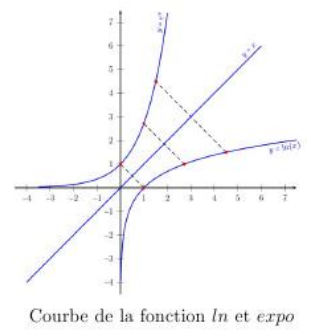Fonction exponentielle - TL
I. Étude de la fonction logarithme exponentielle
1. Définition et notation
La fonction exponentielle notée `$\exp$ est une fonction qui est définie et dérivable sur qui est égale à sa fonction dérivée et qui est strictement positive sur.
Autrement dit
$\bullet\ $L'ensemble de définition de la fonction exponentielle est et l'image de tout réel $x$par la fonction exponentielle est le réel strictement positif noté $\text{exp }x$
on lit exponentielle de $x.$
$\bullet\ $La fonction exponentielle est dérivable sur $\mathbb{R}$ et pour tout $x\in\mathbb{R}$, $\text{exp}'(x)=\text{exp }(x)$
2. Remarque
$\bullet\ $On admet que pour tout $x\in\mathbb{R}$, $\text{exp}(x)=\mathrm{e}^{x}$ où est l'unique réel strictement positif tel
que $\ln\mathrm{e}=1$ et dont une valeur approchée est $\mathrm{e}\cong 2.718$
$\bullet\ \mathrm{e}^{0}=1$ et $\mathrm{e}^{1}=\mathrm{e}$
3. Propriétés
i. Pour tout $\in\mathbb{R}$, $\mathrm{e}^{x}>0$
ii. Pour tout $x\in\mathbb{R}$, $\ln\left(\mathrm{e}^{x}\right)=x$
iii. Si $x<0$ alors on a : $\mathrm{e}^{\ln x}=x$
iv. Si $x>0$ et si $y\in\mathbb{R}$ alors on a : $\ln x=y\Longleftrightarrow\,x=\mathrm{e}^{y}$
Exercice d'application
1. Simplifier autant que possible le nombre suivant : $A=\ln\left(\mathrm{e}^{3}\right)+\mathrm{e}^{\ln 5}-\ln\left(\mathrm{e}^{2}\right)+\mathrm{e}^{\ln 3}$
2. Résoudre dans $\mathbb{R}$, les équations $\ln x=-2$ ; $\mathrm{e}^{x}=2$ et $(\ln x)^{2}-1=0$
4. Autres propriétés
$\mathrm{e}^{x+y}=\mathrm{e}^{x}\mathrm{e}^{y}$
$\mathrm{e}^{-x}=\dfrac{1}{\mathrm{e}^{x}}$
$\mathrm{e}^{x-y}=\dfrac{\mathrm{e}^{x}}{\mathrm{e}^{y}}$
Si $r$ est un nombre rationnel alors on a : $\mathrm{e}^{rx}=\left(\mathrm{e}^{x}\right)^{r}$
5. Représentation graphique
Soit $f$ la fonction telle que $f(x)=\mathrm{e}^{x}$
a. limites aux bornes
$D_{f}=]-\infty\ ;\ +\infty[$
$\bullet\ $ $\begin{array}{rcl} \lim\limits_{x\longrightarrow\,-\infty}f(x)&=&\lim\limits_{x\longrightarrow\,-\infty}\mathrm{e}^{x}\\&=&0
\end{array}$
$\bullet\ $ $\begin{array}{rcl}\lim\limits_{x\longrightarrow\,-\infty}f(x)&=&\lim\limits_{x\longrightarrow\,+\infty}\mathrm{e}^{x}\\&=&+\infty \end{array}$
b. Branches infinies
$\bullet\ $$\lim\limits_{x\longrightarrow\,-\infty}\mathrm{e}^{x}=0$ donc la droite d'équation $y=0$ (l'axe des abscisses) est une asymptote horizontale de $C_{f}$ en $-\infty$
$\bullet\ $ $\lim\limits_{x\longrightarrow\,+\infty}\dfrac{\mathrm{e}^{x}}{x}=+\infty$ donc l'axe des ordonnées est une branche parabolique de $C_{f}$ en $+\infty$
c. Dérivée et sens de variation
$f$ est dérivable sur et pour tout $x\in\mathbb{R}\,f'(x)=\mathrm{e}^{x}$
Or pour tout $x\in\mathbb{R}\;,\mathrm{e}^{x}>0$ donc $f'(x)>0$ d'où $f$ est strictement croissante sur $\mathbb{R}$
d. Tableau de variation
Le tableau suivant est celui des variations de $f$
$\begin{array}{|c|cccc|} \hline x & -\infty & & & +\infty \\ \hline \exp'(x) & & + & & \\\hline & & & & +\infty \\ \exp(x) & & \nearrow & & \\ & 0 & & & \\ \hline \end{array}$
e. Courbe représentative de la fonction exponentielle
$\bullet\ $Équations des tangentes aux points d'abscisses $0$ et $1$
L'équation de la tangente $(T)$ à $C_{f}$ au point d'abscisse $0$ est $\begin{array}{rcl} (T)\ :\ y&=&f'(0)(x-0)+f(0)\\&=&x+1 \end{array}$
L'équation de la tangente $\left(T'\right)$ à $C_{f}$ au point d'abscisse $1$
$\begin{array}{rcl} \left(T'\right)\ :\ y&=&f'(1)(x-1)+f(1)\\&=&\mathrm{e}(x-1)+\mathrm{e}\\&=&\mathrm{e}x\end{array}$
Tableau de valeurs
$$\begin{array}{|c|c|c|c|c|} \hline x&0&1&2&2.5\\ \hline f(x)&1&\mathrm{e}&7.4&12\\ \hline \end{array}$$
$\bullet\ $

II. Équations et inéquations faisant intervenir la fonction exponentielle
1. Équations
$\bullet\ $Propriétés
Si $x$ et $y\in\mathbb{R}$ alors $\mathrm{e}^{x}=\mathrm{e}^{y}\Longleftrightarrow\, x=y$
$\bullet\ $Équations du type $\mathrm{e}^{u(x)}=\mathrm{e}^{v(x)}$
Si $u(x)$ et $v(x)$ sont des expressions bien définies alors on a $\begin{array}{rcl} \mathrm{e}^{u(x)}&=&\mathrm{e}^{v(x)}\\&\Longrightarrow&u(x)\\&=&v(x) \end{array}$
Exemple : Résolvons dans $\mathbb{R}$ les équations suivantes :
$\mathrm{e}^{x-2}=\mathrm{e}^{-x+3}$ et $\mathrm{e}^{x^{2}}=\mathrm{e}^{-x+6}$
2. Inéquations
$\bullet\ $Propriétés : Soient $x$ et $y\in\mathbb{R}$
i. $\mathrm{e}^{x}\geq\mathrm{e}^{y}\Leftrightarrow\, x\geq y$
ii. $\mathrm{e}^{x}\leq \mathrm{e}^{y}\Leftrightarrow\, x\leq y$
iii. $\mathrm{e}^{x}\leq y(y>0)\Leftrightarrow\,x\leq \ln y$
iv. $\mathrm{e}^{x}\geq y(y>0)\Leftrightarrow\,x\geq \ln y$
NB : Les inégalités strictes ci-dessus peuvent être larges.
$\bullet\ $ Exemple : Résoudre dans les inéquations suivantes
i. $\mathrm{e}^{-2x+1}\leq \mathrm{e}^{-4x+6}$
ii. $\mathrm{e}^{x}\geq 5$
III. Fonction comportant l'exponentielle
1. Limites
a. Limite usuelle
$\lim\limits_{x\longrightarrow\,-\infty}x\mathrm{e}^{x}=0$
b. Autre limites
Pour calculer $\lim\limits_{x\longrightarrow\,\alpha}\mathrm{e}^{u(x)}$, on calcule d'abord $\lim\limits_{x\longrightarrow\,\alpha}u(x)$ :
i. Si $\lim\limits_{x\longrightarrow\,\alpha}u(x)=l$ où $l\in\mathbb{R}$ alors $\lim\limits_{x\longrightarrow\,\alpha}\mathrm{e}^{u(x)}=\mathrm{e}^{l}$
ii. Si $\lim\limits_{x\longrightarrow \alpha}u(x)=-\infty$ alors $ \lim\limits_{x\longrightarrow\,\alpha}\mathrm{e}^{u(x)}=0$

Ajouter un commentaire